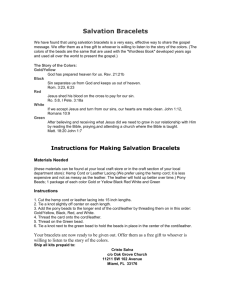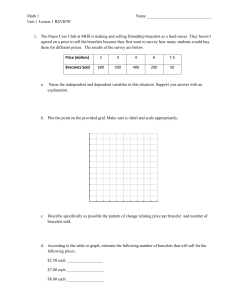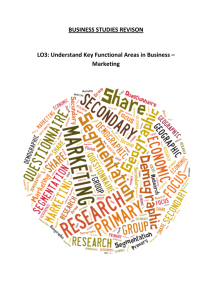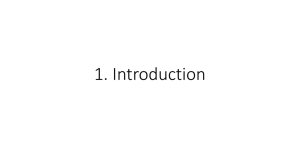2.4 AS90846 Conduct market research for a new or existing product
advertisement
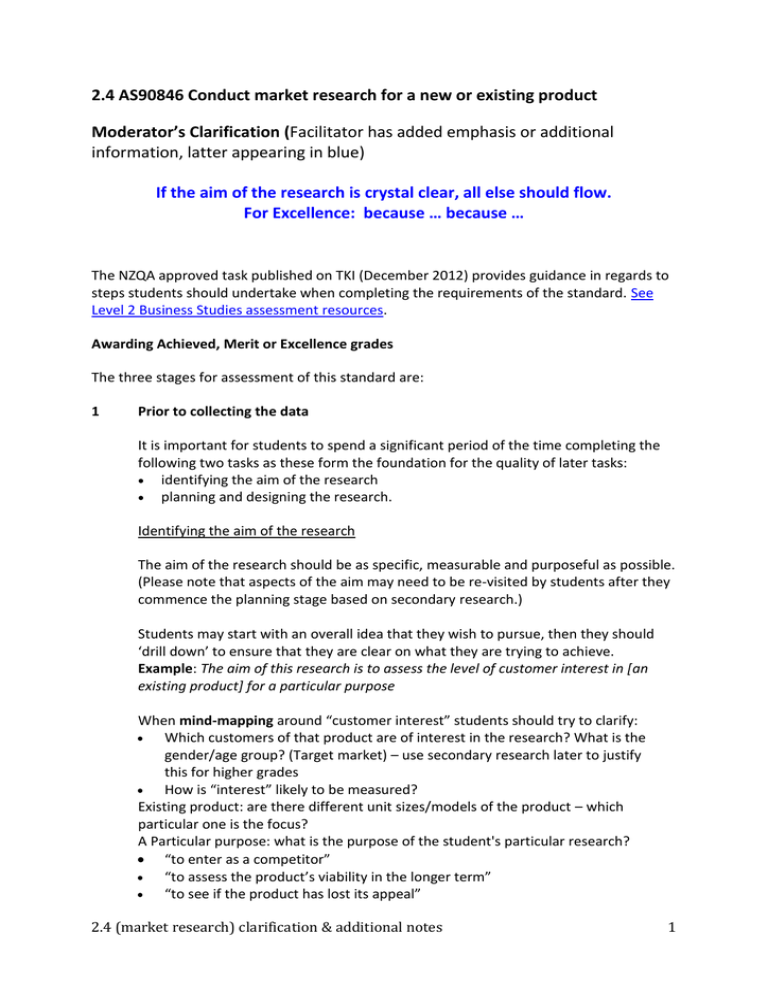
2.4 AS90846 Conduct market research for a new or existing product Moderator’s Clarification (Facilitator has added emphasis or additional information, latter appearing in blue) If the aim of the research is crystal clear, all else should flow. For Excellence: because … because … The NZQA approved task published on TKI (December 2012) provides guidance in regards to steps students should undertake when completing the requirements of the standard. See Level 2 Business Studies assessment resources. Awarding Achieved, Merit or Excellence grades The three stages for assessment of this standard are: 1 Prior to collecting the data It is important for students to spend a significant period of the time completing the following two tasks as these form the foundation for the quality of later tasks: identifying the aim of the research planning and designing the research. Identifying the aim of the research The aim of the research should be as specific, measurable and purposeful as possible. (Please note that aspects of the aim may need to be re-visited by students after they commence the planning stage based on secondary research.) Students may start with an overall idea that they wish to pursue, then they should ‘drill down’ to ensure that they are clear on what they are trying to achieve. Example: The aim of this research is to assess the level of customer interest in [an existing product] for a particular purpose When mind-mapping around “customer interest” students should try to clarify: Which customers of that product are of interest in the research? What is the gender/age group? (Target market) – use secondary research later to justify this for higher grades How is “interest” likely to be measured? Existing product: are there different unit sizes/models of the product – which particular one is the focus? A Particular purpose: what is the purpose of the student's particular research? “to enter as a competitor” “to assess the product’s viability in the longer term” “to see if the product has lost its appeal” 2.4 (market research) clarification & additional notes 1 Such mind-mapping is likely to be based on tools such as BCG, ANSOFF, SWOT, PORTERS. While these provide evidence/answers for the summary of the market situation, and direction for the plan, they do not need to be submitted. Ideally data gathered through these processes will be integrated into the text of the marketing audit. [A SMART goal tool would not be appropriate here as it is about looking to the future. This could be incorporated as part of an excellence-level discussion on improving the market research process.] The finalised aim of the research should always be at the forefront. A potential restated aim: The aim of this research is to assess the likelihood of teenage girls in the school buying leather Pandora bracelets to see if the advertising should be re-focussed towards this new market. Another example of the aim could be: The aim of this research is to assess the likelihood of teenagers in the school buying an iPad mini in the next 6 months to see if my school is representative of the global trend in popularity" Students must be careful to focus on a product OR a brand, not a combination of these. Are they focusing on: Pandora’s leather vs silver bracelets [product] Pandora leather bracelets vs CheaperImitation leather bracelets [brand]? Brand/product confusion limits students to a maximum grade of Achieved as it makes integration of relevant business knowledge difficult. It is not possible to create a sound marketing strategy or write a sound marketing plan without a clear focus on either the product or the brand. Planning and designing This requires students to collect some secondary data to help plan their primary data collection: planning and designing the research designing appropriate primary data collection tools that enable them to collect sufficient valid data and present it appropriately in alignment with the aims and drawing a conclusion. Students need to complete secondary research into the product (and also in relation to its target market), and this may form part of the aim. If students choose to set a limit to the scope of research (such as planning to distribute 20 questionnaires only), this cannot be used as a weakness of the research 2.4 (market research) clarification & additional notes 2 unless there is a valid relevant and applied explanation as to why this is the case in reference to the aim. 2 Collecting and presenting the data While collecting the data teachers should provide guidance to ensure that sufficient data is being collected to support their aim. There is a great deal of information that may be collected that ends up being superfluous to fulfilling the needs of the aim, or not provide enough information to provide adequate information for a conclusion from the research. Collecting and recording sufficient primary data relevant to the aim The method of collection should be briefly stated and must link to the methods outlined in the plan. If they have insufficient data, they will need to re-collect data. The students that do well tend check their data regularly to ensure that they have enough to form a conclusion to link to their aim. If the target market is 16 – 24 year olds and they receive questionnaire responses from mainly 30+, then they haven’t collected sufficient to answer the aims. Presenting the data using a range of appropriate methods A ‘range’ means that two or more types of methods need to be used rather than three pie charts showing the responses to three questions. For guidance about methods, there are web resources that can provide guidance for teachers and students as to which are appropriate methods for the types of data collected, see University of Leicester Presenting numerical data. Providing a conclusion Students at all levels of achievement need to present a clear, coherent conclusion of the findings from the research that aligns to the aim. This can be a single statement. 3 Explaining strengths and weaknesses and the impacts of these on the conclusion and discussing ways to improve the market research process ACHIEVED Students need to draw a conclusion and state what was strong about the research practices, or weak. This is describing which aspects of research helped or hindered reaching a conclusion aligned to the aim. MERIT 2.4 (market research) clarification & additional notes 3 Strength/weaknesses need to be explained. This can be done by using “because” statements of why they were strengths and then describing how it affects the validity of the conclusion(s). EXCELLENCE Students should take the merit criteria one step further by suggesting ways of improving the market research process in the future (relevantly). 2.4 (market research) clarification & additional notes 4
